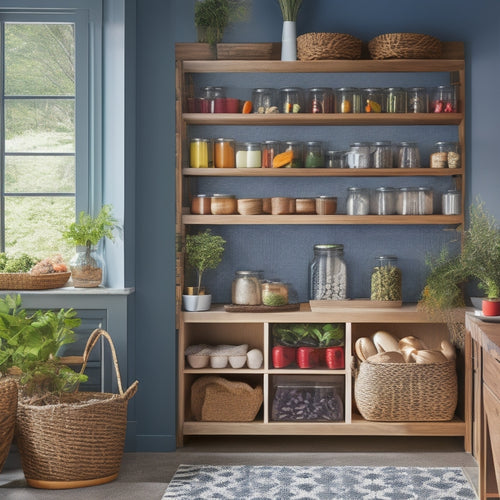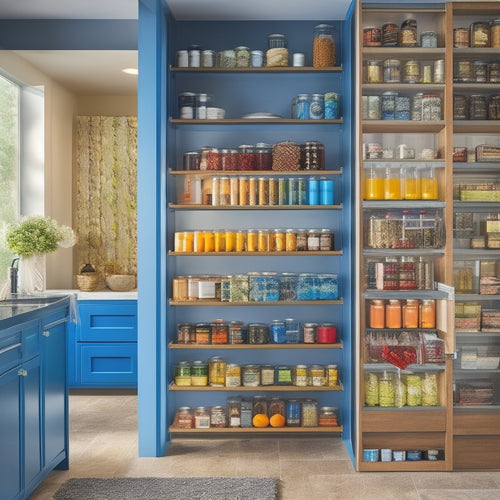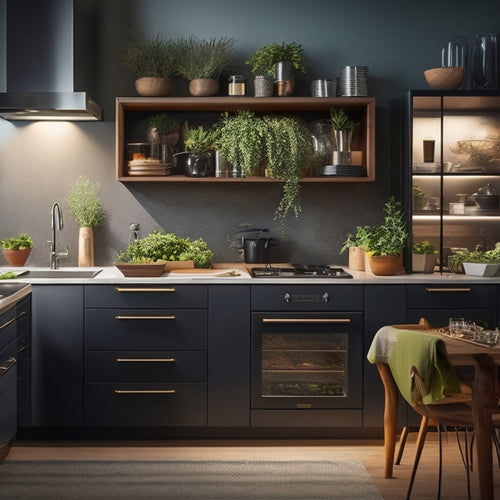
Gluten-Free Meal Planning Made Easy: A Step-by-Step Guide
Share
You're about to take control of your gluten-free diet with a practical, stress-free approach to meal planning. First, set up your gluten-free kitchen by purging gluten-containing products and designating specific zones for cooking. Then, identify gluten-free food sources by exploring health food stores, reading labels carefully, and looking for certifications. Next, find meal planning strategies that work for you, like meal prepping and using time-saving tips. Create a gluten-free grocery list based on your meal plan, and stock your pantry with essentials like gluten-free flours and spices. Now, you're ready to simplify your cooking process and take the guesswork out of gluten-free meal planning - and that's just the beginning.
Key Takeaways
• Set up a gluten-free kitchen by purging gluten-containing products, designating specific zones, and using airtight containers for storage.
• Explore gluten-free food sources, read labels carefully, and look for certifications to ensure safe and healthy options.
• Plan meals in advance, consider meal prepping, and use time-saving tips to simplify the cooking process.
• Stock your pantry with gluten-free essentials, including whole foods, flours, spices, and seasonings, and be aware of hidden gluten sources.
• Stay organized with meal planning tools, including recipe storage, kitchen inventory, and shopping lists to reduce stress and streamline the process.
Setting Up Your Gluten-Free Kitchen
What's the first step in setting up your gluten-free kitchen: purging it of gluten-containing products or dedicating specific zones to gluten-free cooking? Both are critical, but let's start with purging. Get rid of any food items that contain gluten, such as wheat-based bread, pasta, and cereals. This will prevent cross-contamination and guarantee you're not accidentally serving gluten-containing foods to those who need to avoid them.
Next, focus on kitchen organization. Designate specific zones for gluten-free cooking and food storage. For instance, reserve a particular shelf or cabinet for gluten-free ingredients and cooking supplies. This will help prevent cross-contamination and make meal prep more efficient.
When it comes to food storage, use airtight containers and label them clearly to distinguish between gluten-free and gluten-containing foods. This will save you time and reduce the risk of mistakes.
Identifying Gluten-Free Food Sources
Stocking your pantry and fridge with gluten-free staples is essential to successful meal planning, and it starts with identifying reliable sources for these ingredients. You'll want to explore local health food stores, specialty grocery stores, and online retailers that offer a wide range of gluten-free products. When shopping, be sure to read labels carefully and look for certifications like the Gluten-Free Certification Organization (GFCO) or the Celiac Support Association (CSA).
In addition to pantry staples, it's also important to identify gluten-free baking substitutes, such as almond flour, coconut flour, and rice flour. These will become essential tools in your gluten-free cooking arsenal.
For dining out options, research local restaurants that offer gluten-free menus or can accommodate special dietary requests. You can also ask friends, family, or online communities for recommendations.
Meal Planning Strategies Explained
With your pantry and fridge stocked with gluten-free staples, you're ready to start planning meals that are both delicious and safe for those with gluten intolerance or sensitivity.
Now it's time to develop a strategy that makes meal planning a breeze. Start by finding recipe inspiration and meal ideas that cater to your guests' dietary needs. You can browse cookbooks, food blogs, or social media for gluten-free recipes that spark your creativity.
Consider meal prepping on the weekends or one day a week to save time during the week. This will also help you avoid last-minute takeout or dining out, which can be risky for those with gluten intolerance.
To maximize your time in the kitchen, use time-saving tips like cooking proteins in bulk, chopping vegetables in advance, and repurposing leftovers.
Additionally, utilize kitchen hacks like one-pot meals, sheet pan dinners, and slow cooker recipes to simplify your cooking process.
Creating a Gluten-Free Grocery List
You'll need a well-planned grocery list to make certain you have all the necessary gluten-free ingredients on hand to execute your meal plan. This list will be your roadmap to gluten-free success, making sure you can whip up delicious gluten-free recipe ideas and explore various gluten-free dining options.
To create your list, start by reviewing your meal plan and identifying the ingredients needed for each dish. Be sure to include gluten-free staples like rice, quinoa, and gluten-free flours.
Here are some essential items to include on your list:
- Fresh produce, such as fruits and vegetables
- Gluten-free grains, like rice, quinoa, and corn
- Protein sources, including meats, poultry, and fish
- Pantry items, such as gluten-free sauces and condiments
Remember to check the labels of packaged items to make certain they're gluten-free. With your list in hand, you'll be able to shop with confidence and cook up a storm in the kitchen. Happy shopping!
Stocking Your Pantry With Essentials
Take inventory of your pantry and remove any gluten-containing culprits, making space for the essentials that'll serve as the foundation of your gluten-free cooking repertoire. You'll want to focus on whole, unprocessed foods like rice, quinoa, and gluten-free oats.
Stock up on gluten-free flours like almond, coconut, and rice flour for gluten-free baking. Don't forget to grab some gluten-free spices and seasonings to add flavor to your dishes.
Be mindful of hidden gluten sources like soy sauce, teriyaki sauce, and some types of vinegar. Opt for gluten-free alternatives instead. You'll also want to have some gluten-free staples like gluten-free pasta, rice noodles, and canned beans on hand.
Having a well-stocked pantry will make meal prep a breeze and guarantee you're always prepared to whip up a delicious gluten-free meal. Remember, a well-planned pantry is key to successful gluten-free meal planning.
With these essentials, you'll be well on your way to creating tasty, gluten-free meals that everyone will love.
Meal Prep Containers and Tools
Now that your pantry is stocked with gluten-free staples, it's time to contemplate the tools and containers that'll help you prep and store your meals efficiently.
Having the right storage solutions and organization system in place can make all the difference in maintaining a gluten-free diet. You'll want to ponder investing in a variety of container sizes to accommodate different types of meals and ingredients.
Here are some must-haves for your meal prep toolkit:
-
Airtight containers: Perfect for storing dry goods like rice, quinoa, and gluten-free flours.
-
Glass meal prep containers: Ideal for portioning out individual meals and reheating leftovers.
-
Label maker: Helps you quickly identify what's inside each container and when it was prepared.
- Stackable storage bins: Great for keeping your pantry organized and clutter-free.
Budgeting for Gluten-Free Ingredients
Frequently, gluten-free ingredients come with a heftier price tag, forcing you to prioritize your spending and make smart budgeting decisions to maintain a gluten-free lifestyle without breaking the bank.
To stay within your means, start by identifying areas where you can cut costs. Consider buying gluten-free staples in bulk, like rice, quinoa, and gluten-free flours. You can also explore more affordable gluten-free substitutions, such as using corn tortillas instead of gluten-free bread or opting for gluten-free oats instead of almond flour.
When eating out, choose restaurants that offer gluten-free options, and consider dining during off-peak hours or taking advantage of lunch specials to save money. You can also look for online coupons or discount codes to reduce your bill.
Additionally, plan your meals around seasonal and locally sourced ingredients, which tend to be cheaper than exotic or imported options. By being mindful of your spending and making a few adjustments, you can enjoy a gluten-free lifestyle without sacrificing your budget.
Planning Meals for Busy Schedules
With your gluten-free pantry staples in place, you're ready to tackle the next challenge: planning meals that fit seamlessly into your busy schedule. As a busy individual, you need meals that aren't only gluten-free but also quick, easy, and convenient.
Here are some tips to help you plan meals that fit your busy lifestyle:
-
Prepare in advance: Take some time on the weekend to prep meals for the week ahead. Chop veggies, cook proteins, and assemble salads or meal prep containers.
-
Keep it simple: Focus on quick breakfasts like overnight oats or scrambled eggs, and easy lunches like sandwiches or soups.
-
One-pot wonders: Choose recipes that can be cooked in one pot, like stir-fries or skillet dinners, to save time on cleanup.
- Slow cooker recipes: Utilize your slow cooker to prepare meals that simmer all day, like stews or chili, perfect for busy weeknights.
Managing Food Allergies and Intolerances
As you navigate the world of gluten-free meal planning, you'll likely encounter other food allergies and intolerances that require attention, whether it's for yourself or a family member. It's important to identify these allergies and intolerances through allergy testing, which can help you pinpoint specific triggers. Once you have a diagnosis, you can make dietary modifications to ensure a safe and healthy diet.
When it comes to label reading, it's vital to be diligent. Always check the ingredient list for common allergens, and look for certifications like 'free from' or 'made in a dedicated facility.'
Ingredient substitutions can be a game-changer, allowing you to adapt recipes to accommodate multiple allergies. For example, you can swap out dairy milk for almond milk or use gluten-free flours in place of traditional ones.
Staying Organized With Meal Planning Tools
By incorporating meal planning tools into your gluten-free lifestyle, you'll find it easier to stay on track and make certain that you're consistently preparing healthy, allergy-friendly meals. These tools will help you streamline your meal planning process, saving you time and reducing stress.
Here are some essential tools to contemplate:
-
Recipe organization: Keep all your gluten-free recipes in one place, whether it's a digital app or a physical binder. This will help you quickly find recipes that fit your dietary needs.
-
Meal prepping: Plan your meals for the week and prep ingredients in advance to make sure you're always cooking healthy, gluten-free meals.
-
Kitchen inventory: Keep track of the ingredients you have on hand to avoid duplicate purchases and reduce food waste.
- Shopping lists: Create lists of gluten-free staples and ingredients you need to restock, making grocery shopping a breeze.
Frequently Asked Questions
Can I Still Eat Out at Restaurants on a Gluten-Free Diet?
You can still enjoy eating out, but you'll need to be mindful of restaurant options that cater to gluten-free diets and take steps to minimize cross-contamination risks, like asking questions and choosing simple dishes.
Will I Have to Give up My Favorite Comfort Foods?
You don't have to give up your favorite comfort foods! With ingredient substitutions and comfort food alternatives, you can enjoy gluten-free versions of your beloved dishes, and even try gluten-free baking with budget-friendly options.
How Do I Handle Gluten-Free Meal Planning When Traveling?
When traveling, you'll need to plan ahead for gluten-free meals, packing airport snacks like nuts and dried fruits, and being mindful of cross contamination risks at restaurants and food stalls to guarantee a safe and enjoyable trip.
Are Gluten-Free Products Always More Expensive Than Regular Ones?
When you compare costs, you'll find that some gluten-free products are pricier, while others are surprisingly affordable. To budget smart, you'll want to prioritize, plan meals around staples, and explore discount stores or online deals.
Can I Convert My Favorite Recipes to Be Gluten-Free Easily?
"Absence of planning is a plan to fail," so don't worry, you can easily convert your favorite recipes to gluten-free by making simple recipe modifications, such as substituting wheat flour with gluten-free alternatives like almond or coconut flour.
Related Posts
-

Sliding Pantry Storage Ideas for Renters
If you're looking to optimize your rental kitchen, sliding pantry storage solutions could be your answer. Employ vert...
-

Sliding Pantry Organizers With Tiered Racks
Sliding pantry organizers with tiered racks optimize your pantry space and enhance accessibility. These organizers cr...
-

Smart Kitchen Countertop Storage Innovations
Smart kitchen countertop storage innovations are transformative for maximizing your kitchen's potential. You can clea...


